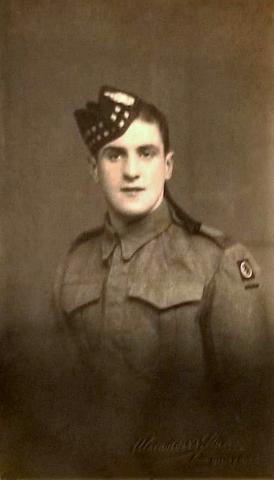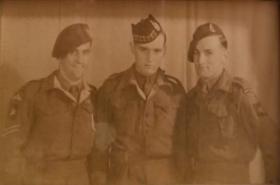Robert Wallace was born on the 21 October 1923 and came from Dumfries in Scotland. Before enlisting he was an engine driver. [1]
He enlisted in The King’s Own Scottish Borders on the 3 March 1939, and was serving with the 7th Battalion (part of the 15th Scottish Infantry Division), when he volunteered for Airborne Forces in 1942. [1] & [2] His profile picture shows Robert in his KOSB uniform.
He did Parachute Course 14 at RAF Ringway, 25 May to 4 June 1942. He carried out two balloon descents and three Whitley aircraft descents successfully, but injured his ankle on the fourth aircraft descent. [3] It is likely he was sent to his unit, the 2nd Parachute Battalion, where he only needed one more ‘jump’ to qualify as an Army Parachutist, instead of doing the whole course again.
Within the 2nd Parachute Battalion, he served with 8 Platoon, ‘C’ Company.
On the 1 November 1942 he was on a troopship bound for North Africa to take part in Operation ‘Torch’, and having landed at Algiers on the 12 November, he moved – with the rest of the Battalion – to Maison Carree, near Maison Blanche airfield. From here, on the 29 November the Battalion emplaned in forty four Douglas C47’s (Dakota’s ) and took off for an operation near Tunis. At 19.00 hours on that same day they dropped at an airfield called Depienne in Tunisia.
‘The Battalion then advanced 12 miles overnight and after a short, sharp engagement captured and secured the airfield at Oudna. Throughout the 30 November they were attacked by armour and aircraft but these were beaten off. There being no sign of the ground troops the Battalion withdrew into the hills before a major enemy assault could be mounted. Here they received a message that our ground forces had been halted 50 miles to the West. From 1 to 3 December under constant attack by day and night from German armour, parachute infantry and aircraft the Battalion fought its way back to Medjez to rejoin our lines. Despite losses of some 260 all ranks they reached the Allied lines intact whilst 50 of the missing rejoined in small groups over the next few days’. [4]
Unfortunately Private Wallace was not amongst those that made it back, having been taken prisoner, just before reaching the safety of Allied lines.
This is his MI9 Iinterview of his capture, transportation to Italy and his subsequent escaped:
1). Capture. At Tunis on 3 Dec 1942 at 1430 hrs. Surrounded after being dropped behind [enemy] lines.
2). Camps in which imprisoned.
Source was flown to Palermo.
Camp 66, Capua: 4 Jan to 6 May 1943.
Camp 70, Monte Urano: 7 May to 12 Sep 1943.
3). Attempted Escapes. Nil.
4). Escape. From Camp 70, Monte Urano on 12 Sep 1943.
Source got through a hole in the fence, slipped by 2 sentries and took rifles off them and threw them in the river, as it was considered not advisable to carry arms.
Source escaped with Rfmn. Burns and Rfmn. O’Brien, both London Irish. He last saw them on 22 Sep 1943 at Gran Sasso. They wanted to rest, but Source decided to move on.
From Monte Urano Source went to Macerata, Ascoli, Aquila and Pescara and then headed west to Guardiagrele, Palata Ridge and Guglionesi, where he met British Troops on 18 Oct 1943.
The whole journey was made on foot and Source was helped by farmers.
He further reported on two incidents under the heading BLACK LIST:
13 Mar 1943. At Camp 66, Capua, No 5 Compound, fourteen P/W’s tried to escape through a sewer. Italians fired up the sewer and wounded one. The remainder were brought back to camp and beaten up by the Italian guards and had to go into hospital.
25 Apr 1943. At Camp 66, Capua, Pte. Smith, 2 Parachute Bn, was shot and killed by guard when trying to escape. [5]
Having been repatriated to the United Kingdom, Private Wallace, was posted back to the 2nd Parachute Battalion in Lincolnshire. ‘C’ Company were billeted at Hungerton Hall and during the his time there he was promoted to Corporal.
On Sunday, 17 September 1944, he boarded a Dakota aircraft of the 314th Troop Carrier Group, USAAF at Saltby aerodrome. He was bound for DZ. ‘X’ near Renkum in Holland as part of Operation ‘Market-Garden’. This was the airborne operation which planned to capture the main road bridge at Arnhem and allow the 30th British Corps to outflank the German Siegfried Line defences and bring about an early end to the war.
He landed successfully and made it to the RV with his Platoon and they set out for their first objective, the railway bridge at the village of Oosterbeek. The mission of capturing the railway bridge was unsuccessful, as it was blown up just as they were moving to capture it.
During the advance to their second objective near the railway station in Arnhem Corporal Wallace’s 8 Platoon was leading the column. On the Utrechtsestraat their advance was stopped by German opposition. At daybreak on Monday small groups commanded by Lieutenants David and Ian Russell had succeeded in crossing the Utrechtseweg near the Municipal Museum. Ian Russell decided to follow the other battalions in their attempt to reach the road bridge.
Corporal Robert Wallace, Private Robert Stokes and some others joined Lieutenant Ian Russell in the grounds of the museum, where they found cover among the trees and bushes. Later Corporal Wallace was ordered to advance under cover to knock out an enemy machine-gun position. After that they waited for an opportunity to go to the road bridge.
Shortly after dark on Monday the 18th, the whole body moved off in file past some burning buildings on the mud bank of the river and worked their way towards the road bridge. Only nine of Ian Russell’s original party were now with him, including Private Stokes and Corporal Wallace. They were about in the middle of a long file and it was difficult to determine who was in command, so Ian Russell kept his own men very close. A few stray shots in front soon developed into very heavy machine-gun fire and in the darkness the file, which was at all times unwieldy, simply disintegrated. Private Stokes and several other men were hit. They moved to their left out of the mud and took up a position in preparation for an anticipated attack. Eventually they got onto higher ground and pushing onwards in the general direction of the bridge encountered heavy opposition. In by-passing this opposition, the strength of the group reduced to five and from the active nature and strength of the opposition, it was now clear that any hope of reaching the bridge was gone and they took cover by the roadside.
At about first light on Tuesday the 19, they met a column advancing along the road towards the bridge. This they joined, but again heavy opposition was encountered so Ian Russell and some men again moved to the left away from the road. As there were Germans everywhere he decided to leave the column and attempt to make a break for the bridge on their own.
Corporal Wallace was one of the wounded, but not severe enough to require hospitalization. Eventually he ended up as a POW via Zutphen in Stalag 12A and given the POW Number 117425. From there he was sent to Stalag 8C at Sagan in Poland. This Camp was evacuated by the Germans in February 1945 and all the prisoners were forced march to the West, away from the Russians.
He was released to the Z/T Reserves on the 13 July 1947. [2]
NOTES:
[1] Escape & Evasion Report. 13 January 1944.
[2] The Parachute Regiment, Transfer & Enlistment Book 06, page 15.
[3] Parachute Course Report, RAF Ringway. June 1942.
[4] Official Battle Honour details.
[5] 2879732. Private. James Smith of the 2nd Parachute Battalion was killed on the 19 April 1943. He is buried in Naples War Cemetery, III. R. 11. The son of James and Janet Smith, of Edinburgh, he was 26 years old when he was killed. The inscription on his headstone reads: IN LOVING MEMORY OF JIM OUR DEARLY LOVED ELDEST SON, WHO DIED IN A PRISON CAMP. DEARLY REMEMBERED ALWAYS.
Created with information kindly researched by R Hilton
Read More


Latest Comments
There are currently no comments for this content.
Add Comment
In order to add comments you must be registered with ParaData.
If you are currently a ParaData member please login.
If you are not currently a ParaData member but wish to get involved please register.